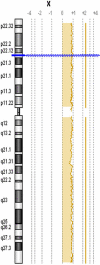High-resolution analysis of DNA copy number alterations in patients with primary open-angle glaucoma
- PMID: 19693294
- PMCID: PMC2728570
High-resolution analysis of DNA copy number alterations in patients with primary open-angle glaucoma
Abstract
Purpose: To determine whether patients with isolated primary open-angle glaucoma (POAG) have evidence of chromosomal copy number alterations.
Methods: Twenty-seven Caucasian and African-American POAG patients and 12 ethnically matched controls were carefully screened for possible glaucoma and tested for chromosomal copy number alterations using high resolution array comparative genomic hybridization.
Results: No POAG patient had evidence of chromosomal copy number alterations when compared to normal ethnically matched controls. Additionally, there was no evidence of somatic mosaicism in any tested POAG patient.
Conclusions: Chromosomal deletions and/or duplications were not detected in POAG patients as compared to controls. Other chromosomal imbalances such as translocations, inversions, and some ploidies cannot be detected by current array comparative genomic hybridization technology, and other nuclear genetic, mitochondrial abnormalities, or epigenetic factors cannot be excluded as a possible contributing factor to POAG pathogenesis.
Figures


References
-
- Tielsch JM, Sommer A, Katz J, Royall RM, Quigley HA, Javitt J. Racial variations in the prevalence of primary open-angle glaucoma. The Baltimore Eye Survey. JAMA. 1991;266:369–74. - PubMed
-
- Gherghel D, Hosking SL, Orgul S. Autonomic nervous system, circadian rhythms, and primary open-angle glaucoma. Surv Ophthalmol. 2004;49:491–508. - PubMed
-
- Spaeth GL. A new classification of glaucoma including focal glaucoma. Surv Ophthalmol. 1994;38(Suppl):S9–17. - PubMed
-
- Wilson MR, Hertzmark E, Walker AM, Childs-Shaw K, Epstein DL. A case-control study of risk factors in open angle glaucoma. Arch Ophthalmol. 1987;105:1066–71. - PubMed
Publication types
MeSH terms
Substances
Grants and funding
LinkOut - more resources
Full Text Sources
Research Materials
